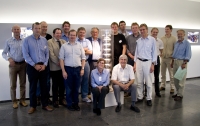 |
 |
|||||||||||||
|
|||||||||||||
|
|||||||||||||
|
There are many official stages to a project financed by the European Commission – from call, proposal, negotiations, contract draft, start of work, annual reports to one of the most official events: the kick-off meeting. Europe's new flagship project on cavity production and exploration of international governance structures, ILC-HiGrade took this step last week. Representatives form all eight work packages were at DESY to present their objectives, their to-do lists and the milestones already achieved. ILC-HiGrade may have eight work packages, but two topics clearly stand out against the rest as they are expected to play a major role in the ILC's Technical Design Phase. The common objective of work packages 6-8: to acquire and dress some 24 cavities from industry and investigate the process that produces high-gradient cavities with a high yield. The cavity exploration is subdivided into distinct work packages dealing with the cavity itself, the couplers and the tuners. The goal includes learning from the production cycle chosen for European X-ray free-electron laser XFEL cavities and from tests in facilities all around the world. In the end, around 30 cavities will have multiply undergone the most thorough tests and comparisons, especially low-power tests to demonstrate the yield needed for ILC cavity mass production, thus helping the experts to set up a well-defined fabrication and preparation cycle. The ILC will need 16,000 perfect cavities, so smooth and reliable fabrication processes in industry will be crucial. With the European XFEL construction starting in a few months and mass cavity production for the linac-driven light source slowly gearing up as well, many researchers are involved in both projects and are expecting a lot of synergy between XFEL and ILC via ILC-HiGrade. “ILC-HiGrade can jump onto XFEL production,” said Lutz Lilje in his talk. “We can quality-control the ILC-HiGrade cavities supporting optical inspection of all cavities and thermal mapping, XFEL can use the ILC-HiGrade-produced cavities in the long run, as spares or for tests with higher energies.” Standard XFEL cavities provide a gradient of 23.4 megavolts per metre, the goal for ILC is 31.5 MV/m. ILC-HiGrade also addresses a central objective of the overall ILC plan for the next years: to find the best model on how a future collider could be governed and investigate possible sites. In this context Steinar Stapnes, secretary of the CERN Council Strategy Group, introduced the plans and goals of his respective body at the start of the meeting. ILC-HiGrade work package 4, Governance, is run by European Regional Director Brian Foster, who has invited another seven experienced scientists with lots of policy experience to join his group, to discuss, contrast the various options for how to run an ILC project during its various stages from construction to decommissioning, make recommendations and produce a final report or the EU. “It is important that we involve the funding authorities, governments, and the EU in this throughout and try to get them to sign on and take responsibility for implementing them,” Foster said. The group will each look at existing models and be in close contact with the GDE group on governance that is acting globally. These activities are complemented by involvement in the coordination of the European efforts and crucial for the eventual acceptance of the project at large: outreach. The six European institutions involved in ILC-HiGrade - DESY, CEA, CERN, CNRS/IN2P3, INFN and Oxford University — will spend the four years of the project's run time improving these components and running the European ILC effort. -- Barbara Warmbein |
|||||||||||||
| © International Linear Collider |
